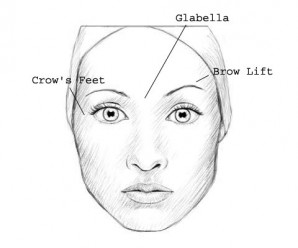Anti-Wrinkle Treatment
We are specialists in safe non-surgical treatments to enhance your natural beauty. All the treatments offered are carried out by professionals trained specifically in the procedures offered.
Anti-Wrinkle Treatments are a proven method by which we can achieve smoothing of the facial muscles. Please read below for more information. They have been used for over 20 years successfully in the UK and the US.
Anti-Wrinkle Treatment Information
Please note that this page informs you of how Botox works and that prior to administration a consultation would be required with the clinician to determine suitability. We will discuss treatment options that will encompass the problems and specific areas of concern that you may have. Botox may not be the most appropriate treatment for the concerns that you may have and this will be discussed in depth at the consultation stage.
Botox is the trade name by which Botulinum Toxin A is widely known. It has been used for a variety of medical conditions including blepharospasm and muscle spasticity for over 20 years. By using the treatment in the facial muscles, e.g. glabella, wrinkles are prevented, as they are a direct results of contracting forehead, eye and mouth muscles.
Facial Anti-Wrinkle Treatment Areas:
- Glabellar Lines (Frown)
- Crow’s Feet Lines
- Infra-periorbital lines (Extension of Crow’s Feet)
- Brow Lift (using Glabella and Crow’s Feet combined)
- Hemifacial Spasm
(Note: Other areas of the face are treatable but they are currently unlicensed)

Common treatment areas
What types of wrinkles are there
Wrinkles on the forehead most commonly appear in two ways:
As vertical lines just above the nose, often referred to as “the elevens”; or horizontal rows across the forehead. The “elevens”, or glabellar lines, result from squinting, scowling, worrying or just plain thinking.
The horizontal lines may result from normal animation while talking, or from holding the brows up with the primary muscle of the forehead (the frontalis) during times of stress, or just naturally. These lines are primarily the result of continual muscle contraction and can become very deep over time.
How do I prepare for Anti-Wrinkle (e.g. Botox) Treatment
Do nothing differently, just go about your normal activities as you would normally.
Who can have Anti-Wrinkle Treatment
Botox Treatment can be used for treating wrinkles in men and women, however men often need slightly higher doses than women.
Who should not have Botox
- People with infection at the proposed injection site.
- People who have previously had an allergic reaction to Botulinum toxin type A injections.
- People with muscle problems or chronic diseases affecting the muscles, such as Myasthenia Gravis, Eaton Lambert syndrome.
- Children under the age of 18 years.
- Women who are pregnant or breast feeding.
How does Botox work
This anti-ageing treatment, commonly known as Botox (BOtulinum TOXin), is often prescribed by doctors to eliminate wrinkles in the upper third of the face. This includes forehead lines, frown lines between the eyebrows and crows’ feet around the eyes. Very fine needles are used so there is very little discomfort and you can resume most of your usual activities immediately after treatment.
How many Botox treatment sessions will I need
Botox works within a few days but can take as long as 14-21 days for the full paralysing effects to show through. Botox anti-wrinkle injections are not permanent, so we recommend repeat treatments at 3-6 monthly intervals to maintain the effects.
Thousands of these treatments are performed every year – noticeable from 2-14 days afterwards and lasting several months. To complement the lasting results of the treatment, we recommend the use of SPF30 sun protection cream, available at all pharmacists.
Over time, with regular botox treatments, the muscles will get thinner and weaken, which means they are less able to create the wrinkles in the first place. This side effect is particularly useful for treating overactive muscles that have become too bulky over time such as in the jaw area. It is also why botox is used in the medical profession to treat muscle spasticities and over-active trigger points such as in chronic muscular pain and headaches & migraines.
Are there side effects of Botox
The pain associated with injections is mild and no local anaesthetic is required. The needles used are very fine and approximately the same diameter as coarse human hair.
You will be able to drive and engage in all of your usual daily activities immediately after your injections. You may develop slight bruising at the injection sites, but otherwise there will be no visible signs of your skincare treatment.
In rare cases, the botox can migrate to nearby muscles, causing some weakness, such as drooping of the upper eyelid. This is a temporary side effect, lasting for a few weeks at most.
Botox injections may on occasions be prescribed for the management of excess sweating; in a small number of cases, there is no discernible effect; unfortunately this is impossible to predict before treatment commences.” ”>
Not looking for this service? Go back to our treatments page and find the one you are.